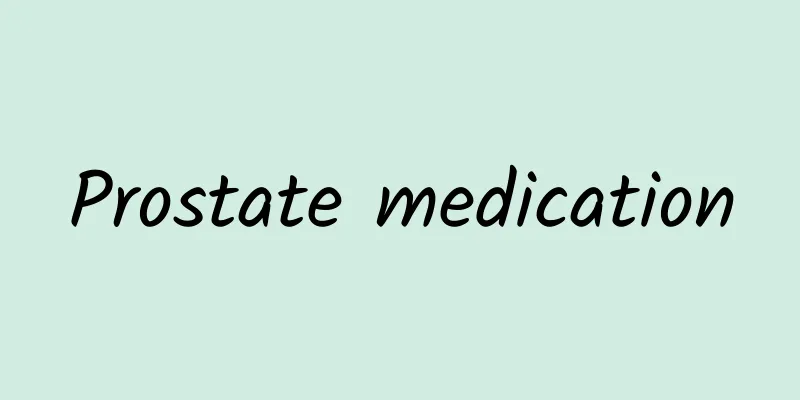Prostate medication

|
Male friends may suffer from prostate disease if they are not careful. This disease mainly requires the use of drug treatment. Since the vast majority of patients suffer from this disease due to fungal infection, antibacterial treatment is required, so antibacterial drugs will be used. However, this treatment is relatively slow to take effect, so you should still insist on taking the medicine to avoid recurrence during treatment. 1. Antimicrobial therapy The detection of pathogenic pathogens in prostatic fluid culture is the basis for selecting antibacterial drug treatment. If patients with non-bacterial prostatitis have signs of bacterial infection and general treatment is ineffective, they can also be appropriately treated with antibacterial drugs. When choosing antibacterial drugs, it is necessary to pay attention to the presence of a prostate-blood barrier composed of lipid membranes between the prostate acini and the microcirculation. The barrier prevents the passage of water-soluble antibiotics, greatly reducing the treatment effect. When prostate stones are present, the stones can become a shelter for bacteria. The above factors constitute the difficulty in the treatment of chronic bacterial prostatitis, which requires a longer course of treatment and is prone to recurrence. Currently, quinolone drugs such as ofloxacin or levofloxacin are recommended. If ineffective, continue to use for 8 weeks. If recurrence occurs and the strain remains unchanged, switch to preventive doses to reduce acute attacks and relieve symptoms. If long-term use of antibiotics induces severe side effects such as pseudomembranous colitis, diarrhea, and the growth of drug-resistant strains in the intestine, the treatment plan needs to be changed. Whether nonbacterial prostatitis is suitable for treatment with antibiotics is still a clinical debate. Patients with "sterile" prostatitis can also use drugs that are effective against bacteria and mycoplasmas, such as quinolones, SMZ-TMP or TMP alone, used in combination with tetracycline and quinolones or used intermittently. If antibiotic treatment is ineffective and it is confirmed to be sterile prostatitis, antibiotic treatment should be discontinued. In addition, using a double balloon catheter to block the prostatic urethra and injecting an antibiotic solution from the urethral cavity into the prostatic duct can also achieve the treatment goal. Type I is mainly treated with broad-spectrum antibiotics, symptomatic treatment and supportive treatment. Type II is recommended to be treated with oral antibiotics, and sensitive drugs are selected. The course of treatment is 4 to 6 weeks, during which the patient should be evaluated for the efficacy. Type III can first take oral antibiotics for 2 to 4 weeks and then evaluate the efficacy. At the same time, non-steroidal anti-inflammatory drugs, α receptor antagonists, M receptor antagonists, etc. are used to improve urination symptoms and pain. Type IV does not require treatment. 2. Anti-inflammatory and analgesic drugs Nonsteroidal anti-inflammatory drugs can improve symptoms. Generally, indomethacin is taken orally or in suppositories. Chinese medicines that use anti-inflammatory, heat-clearing, detoxifying, and hardness-softening drugs also have certain effects. Allopurinol can reduce the concentration of uric acid in the whole body and prostatic fluid. In theory, it can be used as a free radical scavenger, and it can also remove active oxygen components, reduce inflammation, and relieve pain. It is an optional auxiliary treatment method. 3. Physical therapy Prostate massage can empty the concentrated secretions in the prostate duct and drain the infection focus in the obstructed area of the gland. Therefore, for stubborn cases, prostate massage can be performed every 3 to 7 days while using antibiotics. A variety of physical factors are used for prostate physiotherapy, such as microwave, radio frequency, ultrashort wave, medium wave and hot water sitz bath, which are beneficial for relaxing the prostate, posterior urethral smooth muscle and pelvic floor muscle, enhancing antibacterial efficacy and relieving pain symptoms. |
<<: What is the reason for yellow ejaculation?
>>: Reasons why men have leucoderma
Recommend
Take Liuwei Dihuang Pills for weak ejaculation
I believe everyone has heard of Liuwei Dihuang Pi...
Did you know that this is the correct way to do a squat?
Doing some simple fitness exercises in daily life...
Nine foods to keep men strong and healthy
Hormones are not exclusive to women, men also nee...
Better Ways to Treat Premature Ejaculation
Time flies, and so many years have passed in a bl...
Touching this organ of men often can help prolong life
The five senses are one of the important signs fo...
Male urethral narrowing
In men, the urethra and ejaculation are the same ...
Is armpit odor the same as body odor? What is the difference between armpit odor and body odor?
I remember when I was in school, I had a particul...
Can scrotal eczema be treated with dermatitis tablets?
Scrotal eczema is a very common disease among men...
The advantages of a big Adam's apple for boys
Although the Adam's apple is a physiological ...
Picture of the fleshy granules on the penis skin
The male genitals are a very important male repro...
Can male endocrine disorders be cured?
In our daily life, some male friends also have en...
Men can't get hard during sex
The male reproductive organ is a very important o...
How can men improve their sexual function?
Men need to take good care of their bodies. Men a...
How to supplement calcium deficiency in middle-aged men
We know that this society is aging. When people e...
What are the clinical manifestations of prostate hyperplasia?
What are the clinical manifestations of prostate ...









